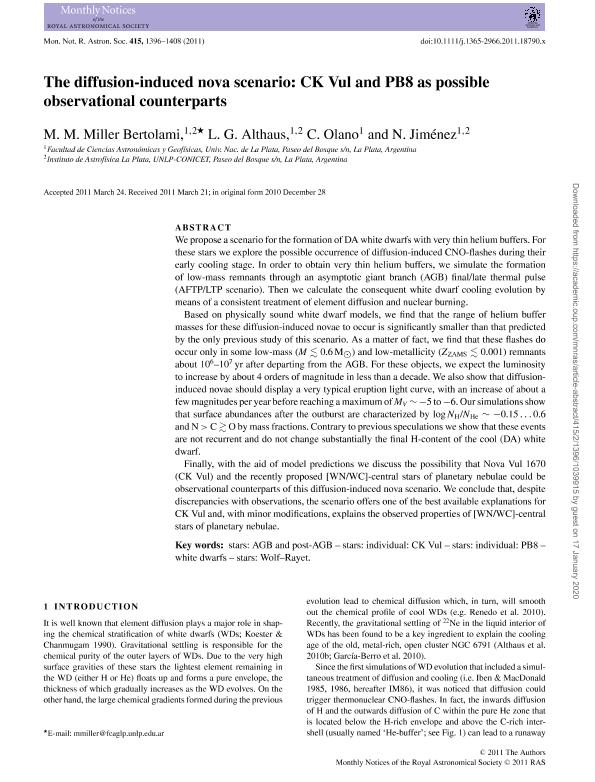Artículo
The diffusion-induced nova scenario: CK Vul and PB8 as possible observational counterparts
Fecha de publicación:
08/2011
Editorial:
Wiley Blackwell Publishing, Inc
Revista:
Monthly Notices of the Royal Astronomical Society
ISSN:
0035-8711
Idioma:
Inglés
Tipo de recurso:
Artículo publicado
Clasificación temática:
Resumen
We propose a scenario for the formation of DA white dwarfs with very thin helium buffers. For these stars we explore the possible occurrence of diffusion-induced CNO-flashes during their early cooling stage. In order to obtain very thin helium buffers, we simulate the formation of low-mass remnants through an asymptotic giant branch (AGB) final/late thermal pulse (AFTP/LTP scenario). Then we calculate the consequent white dwarf cooling evolution by means of a consistent treatment of element diffusion and nuclear burning. Based on physically sound white dwarf models, we find that the range of helium buffer masses for these diffusion-induced novae to occur is significantly smaller than that predicted by the only previous study of this scenario. As a matter of fact, we find that these flashes do occur only in some low-mass (M ≲ 0.6 M⊙) and low-metallicity (ZZAMS≲ 0.001) remnants about 106–107 yr after departing from the AGB. For these objects, we expect the luminosity to increase by about 4 orders of magnitude in less than a decade. We also show that diffusion-induced novae should display a very typical eruption light curve, with an increase of about a few magnitudes per year before reaching a maximum of MV ∼−5 to −6. Our simulations show that surface abundances after the outburst are characterized by log NH/NHe∼−0.15 … 0.6 and N > C ≳ O by mass fractions. Contrary to previous speculations we show that these events are not recurrent and do not change substantially the final H-content of the cool (DA) white dwarf. Finally, with the aid of model predictions we discuss the possibility that Nova Vul 1670 (CK Vul) and the recently proposed [WN/WC]-central stars of planetary nebulae could be observational counterparts of this diffusion-induced nova scenario. We conclude that, despite discrepancies with observations, the scenario offers one of the best available explanations for CK Vul and, with minor modifications, explains the observed properties of [WN/WC]-central stars of planetary nebulae.
Archivos asociados
Licencia
Identificadores
Colecciones
Articulos(CCT - LA PLATA)
Articulos de CTRO.CIENTIFICO TECNOL.CONICET - LA PLATA
Articulos de CTRO.CIENTIFICO TECNOL.CONICET - LA PLATA
Citación
Miller Bertolami, Marcelo Miguel; Althaus, Leandro Gabriel; Olano, Carlos Alberto; Jiménez, N.; The diffusion-induced nova scenario: CK Vul and PB8 as possible observational counterparts ; Wiley Blackwell Publishing, Inc; Monthly Notices of the Royal Astronomical Society; 415; 2; 8-2011; 1396-1408
Compartir
Altmétricas




